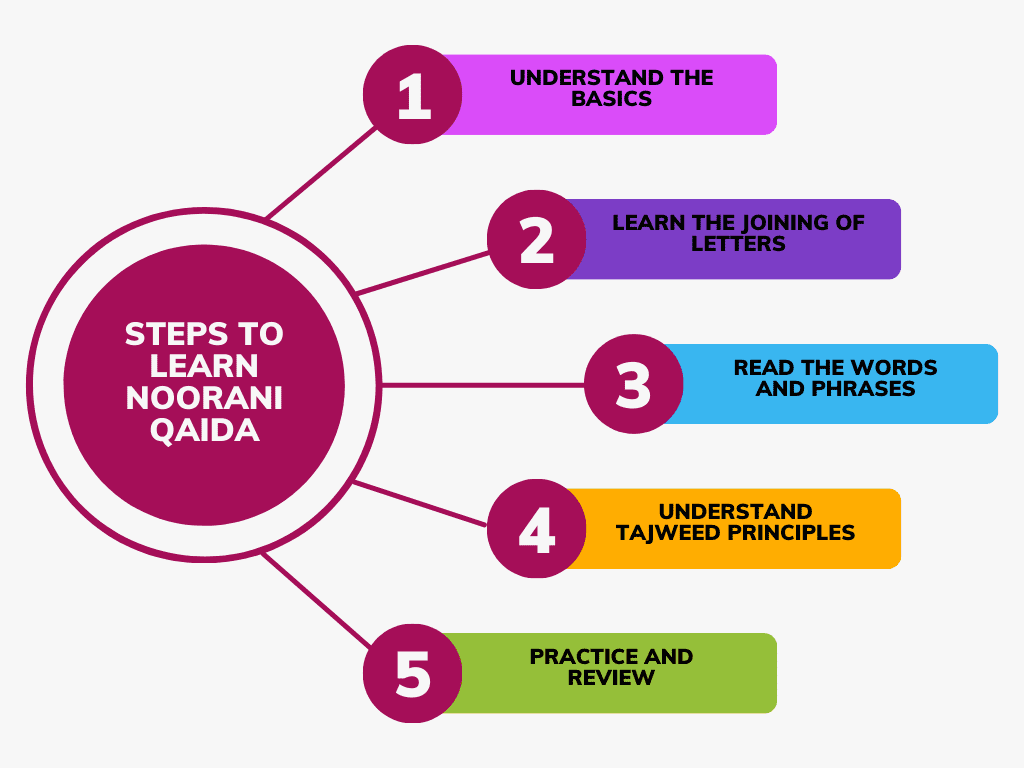Embark on a journey that brings the fluency in Quran recitation within your reach; this is where the first step of learning Noorani Qaida in English begins. Whether you’re a beginner or seeking to refresh your knowledge, this guide is designed to make the process both enlightening and understandable. Join us as we delve into the foundations of Quranic studies, customized for English-speaking Muslims eager to connect with the divine message.
Learning to recite the Quran in its original Arabic form is a spiritual and intellectual pursuit that enriches the soul. However, for many English-speaking Muslims across the world, bridging the gap between their native language and Quranic Arabic can feel like a mighty challenge. But fear not. Noorani Qaida English translation serves as an essential educational tool facilitating this learning with ease and grace.
Through this comprehensive guide, we aim to outline a strategic approach to learn Noorani Qaida book in English, ensuring that the profound beauty and intricate pronunciation of Quranic Arabic become habit for you. Together, we will explore the steps for learning Noorani Qaida in English translation, learning aids, and practical tips to make your journey easy.
Ready to lay the cornerstone of your Qur’anic journey? Let’s begin by mastering the basics with clarity and confidence:
Steps to learn Noorani Qaida in English

Noorani Qaida English is an introductory book for learning the Arabic language, particularly focused on reading the Quran with correct pronunciation using Tajweed. It is designed to incrementally guide learners through the alphabet, basic words, rules of Tajweed and examples required for proper recitation. There are 5 steps to learn this Qaida as per your convenience.
Step 1: Understanding the Basics
Begin with understanding the dots, which differentiate letters from each other. The Arabic alphabets Alif Ba Ta, learning to recognize each letter by visual and sound. Harakat like Fatha, Kasrah, and Dammah, alter the vowel sounds and are critical to accurate pronunciation.
Learning Aids:
Color-coded charts of the Arabic alphabets with English transliteration can be particularly helpful here. There are bundle of resources available in market. You need to choose a tutor to help you to make foundation of these lessons.
Practice:
- Recite the alphabet out loud using the chart before your online tutor.
- Listen to pronunciations by your tutor in one-to-one online classes.
- Engage with interactive exercises focusing on diacritical marks (Fatha, Kasrah, and Dammah).
Step 2: Learning the Joining Letters
Arabic letters often change shape depending on their position in a word. Familiarize yourself with these changes and how letters connect to form coherent words. Often, a latter is joined at start, middle or last of a word gives three different shapes. Simple rule is that the head of letter is joined at start and middle of the word whereas complete letter is joined at end of word.
For example, the letter ع gives different shapes when joining with different ways i.e. عل – لعب – لع . As a beginner, one should memorize the shapes of these letters joining with different ways. Moreover there are some letter which can only be joined at end of the words i.e. ا – د – ذ – ر- ز- و (could not be joined at start and middle of the worlds).
Visual Examples:
Use diagrams illustrating the correct formation of letters and their joining rules. Usually, Noorani Qaida lesson 2 guides you on joining letters with different letters and giving different shapes.
Practice:
- Begin by joining simple letters to form basic words.
- Progress to more complicated combinations as confidence grows.
Step 3: Reading Words and Phrases
Combining what you’ve learnt about individual letters, diacritical marks and joining rules, start forming words and then phrases. Formation of words is easy task if it is started with simple words under the supervision of a tutor. Practice will set you mouth for speaking, gives you Arabic vocabulary and finally make your reading smooth.
Practice:
- Read aloud using example words and sentences provided in the Noorani Qaida in English.
- Regularly review previously learnt concepts to solidify your learning.
Step 4: Tajweed Principles
Tajweed principles are essentials for correct pronunciation of Arabic words when reading the Quran. This stage will introduce you to the rules of nasalization (Ghunna), echoing sounds (Qalqala), and many others.
Visual Aids:
Infographics depicting vowel sounds, diacritical marks, and visual representations of Tajweed rules can simplify learning. Tajweedi Qaida is designed to teach these rules in simple and easy way.
Practice:
- Apply pronunciation rules while reciting, starting with short sentences.
- Record your recitation and compare it with expert reciters.
Step 5: Practice and Review
Consistent practice is crucial. Revise earlier sections and continue applying these rules as you read. Set a specific time daily to practice Qaida. Read explanations mentioned with each lesson. Consistency is key to master in everything.
Learning Aids:
Access to a Noorani Qaida English PDF can aid home practice.
Practice:
- Set a regular practice schedule and stick to it.
- Participate in online review sessions and quizzes to test your knowledge.
Conclusion
Summing up our journey through the comprehensive Guide to Learn Noorani Qaida in English, we have explored the foundational steps to gain proficiency in Quranic recitation. This guide has served not just as a roadmap for beginners but also as a beacon for continuous learning for those on the path of mastery. To solidify your reading skills and take tangible steps towards fluency, we highly encourage you to begin applying what you’ve learned. Engage with our vibrant community of interactive tutors, who can provide personalized guidance and support.
Embark on this transformative journey today and learn the beauty of the Noorani Qaida as it enhances your Quranic recitation.